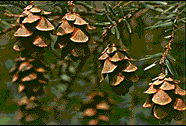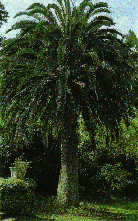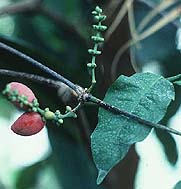Gymnosperms
Reminder: Clicking on the picture will take you to the site where I originally found it.
Gymnosperms are defined as plants which have naked seeds. You won't find these seeds arrested for indecent exposure, but you will find them in cones or exposed to the air. A naked seed is one not enclosed in a plant ovary (fruit).
Most often, the seeds of gymnosperms are found in cones. Picture a pine cone, and you're visualizing the seed-bearing portion of a pine tree.
Seeds are an amazing plant adaptation. The seed allows plants to reproduce while not relying on water as a means of transport. Once seeds had developed, the conifers spread over the world.
Gymnosperms have adapted to drier and cooler conditions than their predecessors. You'll find gymnosperms dominating barren landscapes still. Juniper, pine and other naked seed plants abound.
The gymnosperms are rightfully divided into four divisions. They are:
- Coniferophyta
, the pine trees and their relatives
- Cycadophyta
, the palm-like plants which date to the time of the dinosaurs
- Ginkgophyta
, also known as ginkgo trees, and
- Gnetophyta
, a neat-o bridge from the gymnosperms to the angiosperms (I couldn't resist the pun)
Coniferophyta
Coniferophyta (the pine trees and other cone-bearing plants)
 The most familiar of the gymnosperms are the conifers. All of these trees and shrubs have needles or scaly leaves and bear cones instead of fruits. Most common in this division are the pine trees and their relatives.
The most familiar of the gymnosperms are the conifers. All of these trees and shrubs have needles or scaly leaves and bear cones instead of fruits. Most common in this division are the pine trees and their relatives.
The conifers can brag to have both the largest above-ground and longest-lived plants. The giant redwoods may be over 100 meters tall and 10 meters wide. (300 feet by 30 feet) There are bristlecone pine over 4600 years old. Wow!
Sometimes, we see a cone on the ground or spot a pointed tree in the distance and assume it's a pine tree. There are more than just pine in this group. Among the pine-like trees are the hemlocks, firs, spruces, redwoods, cedars, sequoias and others. Fir or spruce trees are most often mistaken for pine.
There are more than just pointy trees in this phylum. There are the junipers, usually shrubs but often in tree form. There are the softer needled yews. There is also the tamarack, or larch trees. These drop their needles in the fall.
Cycadophyta
Cycadophyta (palm-like plants often seen with pictures of dinosaurs)
 Cycads were once a dominant plant on earth. Today, they're fairly rare and vanishing. They look a lot like palm trees, but these are real gymnosperms. Like the palm trees, the cycads live where weather is generally warm.
Cycads were once a dominant plant on earth. Today, they're fairly rare and vanishing. They look a lot like palm trees, but these are real gymnosperms. Like the palm trees, the cycads live where weather is generally warm.
Like their naked-seed cousins, cycads bear cones. There are male cones which produce pollen and female cones which will bear the seeds. The cones of the cycads are actually modified leaves.
Cycads are sometimes called living fossils. Cycads really do belong to another time. They flourished along side the dinosaurs, and they were very abundant. Today, only a handful of species remain, but because they make good ornamental plants, humans are interested in keeping them around.
Ginkgophyta
Ginkgophyta (Ginkgo trees)
 Once in a while you get a plant or an animal that's really unique. Ginkgo trees are not only in a class by themselves, they're the sole survivor in their division.
Once in a while you get a plant or an animal that's really unique. Ginkgo trees are not only in a class by themselves, they're the sole survivor in their division.
There once was an abundance of ginkgo trees of all types, but that was over a hundred million years ago. Now, there is one species, the Ginkgo biloba tree. That tree would have gone extinct as well, were it not for the careful horticulture of some Buddhist monks in Japan. Because of this, it has the nickname of "tree of the pagodas."
Once you've seen a ginkgo leaf, chances are you'll identify ginkgo easily. The leaf is fan-shaped and usually has a notch in the middle.
This species produce male trees and female trees. The female trees produce seeds with an unusual effect. When the seeds of the ginkgo decompose, they smell like rancid butter. It's a nasty scent, and the seeds squash easily and make a mess. These seeds are covered by a false fruit. This marks an important transition to the angiosperms.
Gnetophyta
Gnetophyta (gnetophytes)
 The gnetophytes (roughly pronounced "neat-o fights") are lost somewhere in between the conifers and the flowering plants. These are truly transitional. There are only three living genera of gnetophytes (genera is the plural of genus). First, there is gnetum, a tropical vine. Then ephedra, nicknamed "Mormon tea" and the source for ephedrine. Finally there is welwitschia, a bizarre African plant with only two leaves.
The gnetophytes (roughly pronounced "neat-o fights") are lost somewhere in between the conifers and the flowering plants. These are truly transitional. There are only three living genera of gnetophytes (genera is the plural of genus). First, there is gnetum, a tropical vine. Then ephedra, nicknamed "Mormon tea" and the source for ephedrine. Finally there is welwitschia, a bizarre African plant with only two leaves.
The gnetophytes are fairly rare, and found in unusual environments. The gnetum is found in rain forests, welwitshia is found in the desert, and ephedra is found in the dry regions of North America and China.
In spite of their appearance to flowering plants like grasses and vines, the gnetophytes bear naked seeds. Both male and female cone-like structures are present. This phylum is the closest living phylum to the flowering plants however.
Back to the bryophytes,
to vascular spore-bearing plants,
peek at the angiosperms,
back to the main plant page, or
return to the overview.
 The gnetophytes (roughly pronounced "neat-o fights") are lost somewhere in between the conifers and the flowering plants. These are truly transitional. There are only three living genera of gnetophytes (genera is the plural of genus). First, there is gnetum, a tropical vine. Then ephedra, nicknamed "Mormon tea" and the source for ephedrine. Finally there is welwitschia, a bizarre African plant with only two leaves.
The gnetophytes (roughly pronounced "neat-o fights") are lost somewhere in between the conifers and the flowering plants. These are truly transitional. There are only three living genera of gnetophytes (genera is the plural of genus). First, there is gnetum, a tropical vine. Then ephedra, nicknamed "Mormon tea" and the source for ephedrine. Finally there is welwitschia, a bizarre African plant with only two leaves. The most familiar of the gymnosperms are the conifers. All of these trees and shrubs have needles or scaly leaves and bear cones instead of fruits. Most common in this division are the pine trees and their relatives.
The most familiar of the gymnosperms are the conifers. All of these trees and shrubs have needles or scaly leaves and bear cones instead of fruits. Most common in this division are the pine trees and their relatives. Cycads were once a dominant plant on earth. Today, they're fairly rare and vanishing. They look a lot like palm trees, but these are real gymnosperms. Like the palm trees, the cycads live where weather is generally warm.
Cycads were once a dominant plant on earth. Today, they're fairly rare and vanishing. They look a lot like palm trees, but these are real gymnosperms. Like the palm trees, the cycads live where weather is generally warm. Once in a while you get a plant or an animal that's really unique.
Once in a while you get a plant or an animal that's really unique.